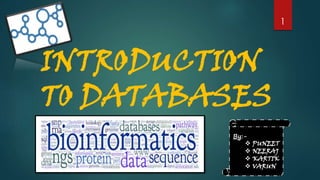
Primary and secondary databases ppt by puneet kulyana
- 1. INTRODUCTION TO DATABASES By:- PUNEET NEERAJ KARTIK VARUN 1
- 2. INDEX/CONTENTS Introduction Data & Information Database Biological Databases Types of Databases - Primary Databases - Secondary Databases - Composite Databases References 2
- 4. DATA & INFORMATION DATA Data is raw, unorganized facts that need to be processed. Example:- Each student's test score is one piece of data. INFORMATION When data is processed, organized, structured or presented in a given context so as to make it useful, it is called information. Example:- The average score of a class or of the entire school is information that can be derived from the given data. 4
- 5. DATA INFORMATION Definition (Oxford Dictionaries) Facts and statistics collected together for reference or analysis Facts provided or learned about something or someone Data as processed, stored, or transmitted by a computer Refers to Raw Data Analyzed Data Description Qualitative Or Quantitative Variables that can be used to make ideas or conclusions A group of data which carries news and meaning In the form of Numbers, letters, or a set of characters. Ideas and inferences Collected via Measurements, experiments, etc. Linking data and making inferences Represented in A structure, such as tabular data, data tree, a data graph, etc. Language, ideas, and thoughts based on the data Interrelation Information that is collected Data that has been processed C O M P A R I S O N B E T W E E N D A T A & I N F O R M A T I O N 5
- 6. S. No. Type of data Example(s) Weblinks 1. Sequence of biomolecules viz., DNA, RNA, proteins GenBank, EMBL, DDBJ, Swiss-Prot, PIR (i) www.ncbi.nlm.nih.gov/genba nk/ (ii) https://www.ebi.ac.uk/embl/ (iii) www.ddbj.nig.ac.jp/ (iv)http://web.expasy.org/docs/s wiss-prot_guideline.html (v) http://pir.georgetown.edu/ 2. Bio-molecular structures PDB http://www.rcsb.org/pdb/home /home.do 3. Bibliography/scientific literature ** PubMed, Scopus (Search engine) (i) www.ncbi.nlm.nih.gov/pubme d (ii) www.scopus.com 4. Patent databases USPTO www.uspto.gov/ 5. Metabolic pathways / molecular interactions KEGG http://www.genome.jp/kegg/pa thway.htm 6 TYPES OF DATA & INFORMATION Databases are categorized based on the data type. A few examples are listed below:-
- 7. DATABASE??? A database is a collection of data in an organized manner, which is accessible in various ways. 7
- 8. WHAT ARE THE BIOLOGICAL DATABASES ??? 8
- 9. Biological Databases serve a critical purpose in the collation and organization of data related to biological systems. They provide a computational support and a user-friendly interface to a researcher for a meaningful analysis of biological data. 9
- 10. TYPES OF DATABASES Primary Databases Secondary Databases 10
- 11. PRIMARY DATABASES Contains bio-molecular data in its original form. Experimental results are submitted directly into the database by researchers, and the data are essentially archival in nature. Once given a database accession number, the data in primary databases are never changed. Examples :- GenBank, EMBL and DDBJ for DNA/RNA sequences, SWISS-PROT and PIR for protein sequences and PDB for molecular structures. 11
- 12. GenBank Database from NCBI, includes sequences from publicly available resources. http://www.ncbi.nlm.nih.gov/genbank/ 12
- 13. EMBL European Molecular Biological Laboratory Nucleic acid database from EBI (European Bioinformatics Institute) Produced in collaboration with DDBJ and GenBank Search engine – SRS (Sequence Retrieval System) http://www.ebi.ac.uk/ 13
- 14. DDBJ DNA Databank of Japan Started in 1986 in collaboration with GenBank Produced and maintained at NIG (National Institute of Genetics) http://www.ddbj.nig.ac.jp/ 14
- 15. SWISS PROT Annotated sequence database established in 1986 Consists of sequence entries of different lie formats Similar format to EMBL http://us.expasy.org/sprot/sprot-top.html http://www.ebi.ac.uk/uniprot/ 15
- 16. PIR Protein Information Resource A division of National Biomedical Research Foundation (NBRF) in U.S. One can search for entries or do sequence similarity search at PIR site. http://pir.georgetown.edu/ 16
- 17. TrEMBL Translated European Molecular Biology Laboratory Computer annotated supplement of SWISS PROT. Contains all the translations of EMBL nucleotide sequence entries not yet integrated in SWISS PROT. http://www.ebi.ac.uk/trembl/ 17
- 18. COMPOSITE DATABASES Collection of various primary database sequences Renders sequence searching highly efficient as it searches multiple resources Examples :- NRDB (Non Redundant Database), OWL, MIPSX, SWISS PROT + TrEMBL 18
- 19. 19
- 20. SECONDARY DATABASES Contains data derived from the results of analysing primary data Manually created or automatically generated Contains more relevant and useful information structured to specific requirements Example :- PROSITE, PRINTS, BLOCKS, Pfam 20
- 21. SECONDARY DATABASES SECONDARY DATABASE PRIMARY SOURCE INFORMATION STORED PROSITE SWISS PROT Regular expression BLOCKS PROSITE/PRIN TS Aligned motifs(blocks) PRINTS OWL (Composite DB) Aligned motifs Pfam SWISS PROT Hidden Markov Models Profile SWISS PROT Weighted Matrices(profile) 21
- 22. PROSITE Families of proteins Can search using regular expressions Similar to unix commands using wildcards, etc. E.g., [AC]-x-V-x(4)-{ED} Interpreted as: [Ala or Cys]-any-Val-any-any-any- any-{any but Glu or Asp} Families exhibit these patterns So we can search over families http://ca.expasy.org/prosite/ 22
- 23. BLOCKS Motifs/blocks are created by automatically detecting the most conserved regions of each protein family. 23
- 24. PRINTS Most protein families are characterized not by one, but by several conserved motifs Fingerprints are groups of conserved motifs excised from sequence alignments Taken together, they provide diagnostic family signatures. They are the basis of the PRINTS database, and are stored in the form of aligned motifs. Input about protein families is done manually 24
- 25. Pfam Maintained by the Sanger Centre (Cambridge) Protein families aligned using HMMs Hidden Markov Models Given a new sequence Find families which the sequence might fit into Sequence Coverage 11912 families Split into Pfam-A (high quality) and Pfam-B (low quality) http://pfam.sanger.ac.uk/ 25
- 26. 26
- 27. PRIMARY VS SECONDARY DATABASES 27
- 28. REFERENCES Class notes ESSENTIAL BIOINFORMATICS- Jin Xiong file:///C:/Users/student/Downloads/DATABASES%2 0IN%20BIOINFORMATICS.pdf https://www.ebi.ac.uk/training/online/course/bioinfor matics-terrified/what-database/relational- databases/primary-and-secondary-databases http://www.diffen.com/difference/Data_vs_Informa tion Google images 28
- 29. 29
